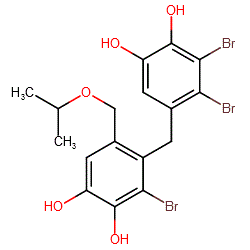GtoPdb is requesting financial support from commercial users. Please see our sustainability page for more information.
|
Compound class:
Synthetic organic
Comment: HPN is a synthetic bromophenol analogue of the algal-derived compound, BPN (PubChem CID10995003). It acts as a competitive inhibitor of the type 2 diabetes target, protein tyrosine phosphatase 1B (PTP1B; gene symbol PTPN1) [1]. HPN is cell permeable and orally active, and exhibits a hypoglycaemic effect in animal models [2].
Ligand Activity Visualisation ChartsThese are box plot that provide a unique visualisation, summarising all the activity data for a ligand taken from ChEMBL and GtoPdb across multiple targets and species. Click on a plot to see the median, interquartile range, low and high data points. A value of zero indicates that no data are available. A separate chart is created for each target, and where possible the algorithm tries to merge ChEMBL and GtoPdb targets by matching them on name and UniProt accession, for each available species. However, please note that inconsistency in naming of targets may lead to data for the same target being reported across multiple charts. ✖ |
|
|||||||||||||||||||||||||||||||||||
| References |
|
1. Luo J, Xu Q, Jiang B, Zhang R, Jia X, Li X, Wang L, Guo C, Wu N, Shi D. (2018)
Selectivity, cell permeability and oral availability studies of novel bromophenol derivative HPN as protein tyrosine phosphatase 1B inhibitor. Br J Pharmacol, 175 (1): 140-153. [PMID:29059712] |
|
2. Shi D, Guo S, Jiang B, Guo C, Wang T, Zhang L, Li J. (2013)
HPN, a synthetic analogue of bromophenol from red alga Rhodomela confervoides: synthesis and anti-diabetic effects in C57BL/KsJ-db/db mice. Mar Drugs, 11 (2): 350-62. [PMID:23364683] |







